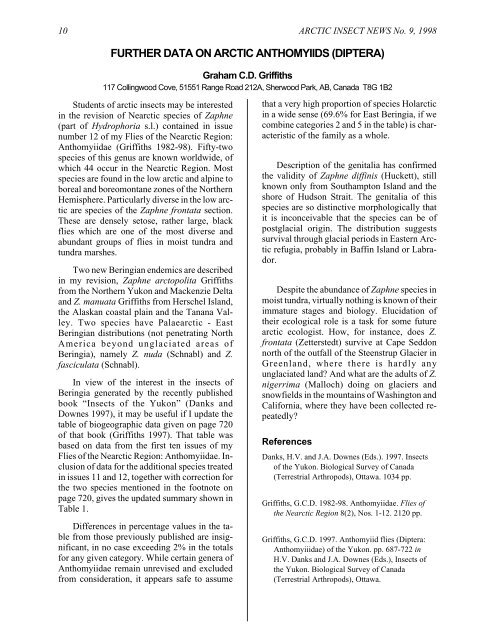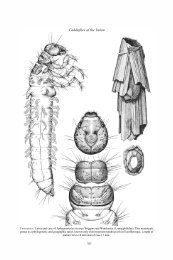No. 9 1998 ARC TIC IN SECT NEWS - Department of Biological ...
No. 9 1998 ARC TIC IN SECT NEWS - Department of Biological ...
No. 9 1998 ARC TIC IN SECT NEWS - Department of Biological ...
You also want an ePaper? Increase the reach of your titles
YUMPU automatically turns print PDFs into web optimized ePapers that Google loves.
10 <strong>ARC</strong><strong>TIC</strong> <strong>IN</strong><strong>SECT</strong> <strong>NEWS</strong> <strong>No</strong>. 9, <strong>1998</strong><br />
FURTHER DATA ON <strong>ARC</strong><strong>TIC</strong> ANTHOMYIIDS (DIPTERA)<br />
Graham C.D. Griffiths<br />
117 Collingwood Cove, 51551 Range Road 212A, Sherwood Park, AB, Canada T8G 1B2<br />
Students <strong>of</strong> arc tic in sects may be interested<br />
in the revision <strong>of</strong> Nearc tic species <strong>of</strong> Zaphne<br />
(part <strong>of</strong> Hydrophoria s.l.) contained in issue<br />
number 12 <strong>of</strong> my Flies <strong>of</strong> the Nearc tic Region:<br />
Anthomyiidae (Griffiths 1982-98). Fifty-two<br />
species <strong>of</strong> this genus are known worldwide, <strong>of</strong><br />
which 44 occur in the Nearc tic Region. Most<br />
species are found in the low arctic and alpine to<br />
boreal and boreomontane zones <strong>of</strong> the <strong>No</strong>rthern<br />
Hemisphere. Par tic u larly diverse in the low arc -<br />
tic are species <strong>of</strong> the Zaphne frontata section.<br />
These are densely setose, rather large, black<br />
flies which are one <strong>of</strong> the most diverse and<br />
abundant groups <strong>of</strong> flies in moist tun dra and<br />
tundra marshes.<br />
Two new Beringian endemics are described<br />
in my revision, Zaphne arctopolita Griffiths<br />
from the <strong>No</strong>rthern Yu kon and Mackenzie Delta<br />
and Z. manuata Griffiths from Herschel Island,<br />
the Alaskan coastal plain and the Tanana Val -<br />
ley. Two spe cies have Palaearctic - East<br />
Beringian distributions (not penetrating <strong>No</strong>rth<br />
Amer ica be yond unglaciated ar eas <strong>of</strong><br />
Beringia), namely Z. nuda (Schnabl) and Z.<br />
fasciculata (Schnabl).<br />
In view <strong>of</strong> the interest in the in sects <strong>of</strong><br />
Beringia generated by the re cently published<br />
book “In sects <strong>of</strong> the Yu kon” (Danks and<br />
Downes 1997), it may be use ful if I up date the<br />
table <strong>of</strong> biogeographic data given on page 720<br />
<strong>of</strong> that book (Griffiths 1997). That table was<br />
based on data from the first ten issues <strong>of</strong> my<br />
Flies <strong>of</strong> the Nearc tic Region: Anthomyiidae. In -<br />
clusion <strong>of</strong> data for the additional species treated<br />
in issues 11 and 12, together with cor rec tion for<br />
the two species men tioned in the footnote on<br />
page 720, gives the updated summary shown in<br />
Table 1.<br />
Differences in percentage values in the ta -<br />
ble from those previously published are insig -<br />
nificant, in no case exceeding 2% in the to tals<br />
for any given category. While cer tain genera <strong>of</strong><br />
Anthomyiidae re main unrevised and excluded<br />
from consideration, it appears safe to assume<br />
that a very high proportion <strong>of</strong> species Holarctic<br />
in a wide sense (69.6% for East Beringia, if we<br />
combine categories 2 and 5 in the table) is char -<br />
acteristic <strong>of</strong> the family as a whole.<br />
Description <strong>of</strong> the gen i ta lia has confirmed<br />
the va lid ity <strong>of</strong> Zaphne diffinis (Huckett), still<br />
known only from Southampton Island and the<br />
shore <strong>of</strong> Hudson Strait. The gen i ta lia <strong>of</strong> this<br />
species are so dis tinc tive morphologically that<br />
it is inconceivable that the species can be <strong>of</strong><br />
postglacial or i gin. The dis tri bu tion sug gests<br />
survival through gla cial pe ri ods in East ern Arc -<br />
tic refugia, probably in Baffin Island or Labra -<br />
dor.<br />
Despite the abundance <strong>of</strong> Zaphne spe cies in<br />
moist tundra, virtually noth ing is known <strong>of</strong> their<br />
immature stages and bi ol ogy. Elucidation <strong>of</strong><br />
their ecological role is a task for some future<br />
arc tic ecol o gist. How, for in stance, does Z.<br />
frontata (Zetterstedt) survive at Cape Sed don<br />
north <strong>of</strong> the out fall <strong>of</strong> the Steenstrup Glacier in<br />
Green land, where there is hardly any<br />
unglaciated land? And what are the adults <strong>of</strong> Z.<br />
nigerrima (Malloch) do ing on gla ciers and<br />
snowfields in the mountains <strong>of</strong> Washington and<br />
California, where they have been collected re -<br />
peatedly?<br />
References<br />
Danks, H.V. and J.A. Downes (Eds.). 1997. Insects<br />
<strong>of</strong> the Yukon. <strong>Biological</strong> Survey <strong>of</strong> Canada<br />
(Terrestrial Arthropods), Ottawa. 1034 pp.<br />
Griffiths, G.C.D. 1982-98. Anthomyiidae. Flies <strong>of</strong><br />
the Nearctic Region 8(2), <strong>No</strong>s. 1-12. 2120 pp.<br />
Griffiths, G.C.D. 1997. Anthomyiid flies (Diptera:<br />
Anthomyiiidae) <strong>of</strong> the Yukon. pp. 687-722 in<br />
H.V. Danks and J.A. Downes (Eds.), Insects <strong>of</strong><br />
the Yukon. <strong>Biological</strong> Survey <strong>of</strong> Canada<br />
(Terrestrial Arthropods), Ottawa.
















